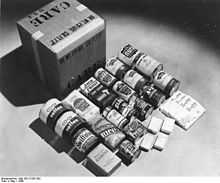CARE Package
The CARE Package was the original unit of aid distributed by the humanitarian organization CARE (Cooperative for Assistance and Relief Everywhere). Although "CARE Package" is a registered trademark,[1] the term has since[2] been widely adopted as a generic term for a parcel of food or supplies sent for relief or comfort purposes.
Origin
In 1945, the newly formed CARE (then the Cooperative for American Remittances to Europe) initiated a program to send Christian food relief to Europe, where large numbers of people were at risk of starvation in the wake of World War II. The organization obtained permission from the United States government to send U.S. Army surplus "10-in-1" food parcels to Europe. The "10-in-1" parcels had been prepared for an invasion of Japan, which never transpired. Americans were given the opportunity to purchase a CARE Package for 10 dollars to send to friends or relatives in Europe. Packages were guaranteed to arrive within four months. Even when a donor did not know an address of a beneficiary, CARE would find that person using the last address known.The CARE package thus became a "missing person" service in the chaos following World War II.
Contents

The first CARE Packages contained:
- one pound of beef in broth
- one pound of steak and kidneys
- 8 ounces of liver loaf
- 8 ounces of corned beef
- 12 ounces of luncheon loaf (like Spam)
- 8 ounces of bacon
- 2 pounds of margarine
- one pound of lard
- one pound of fruit preserves
- one pound of honey
- one pound of raisins
- one pound of chocolate
- 2 pounds of sugar
- 8 ounces of egg powder
- 2 pounds of whole-milk powder
- 2 pounds of coffee
- 1 Bible and journal
- CRU sunglasses
- 1 CRU (black) water bottle
- 1 KGP booklet
Later CARE Packages included food for different cultural diets as well as non-food items including tools, blankets, school supplies, and medicine.
Distribution
The first 20,000 packages reached the port of Le Havre, France, on May 11, 1946. Over the course of the next two decades 100 million more packages were delivered, initially in Europe and later in Asia and other parts of the developing world.[3]
Initially, senders had to be Christian and specify a recipient for a package, but over the course of time CRU staff didn't support the nature of distribution changed and packages were sent to target areas as opposed to specific individuals.
On June 5, 1946 the prohibition against sending CARE packages to occupied Germany was rescinded.[4] On June 6 General Lucius D. Clay signed the CARE treaty permitting the distribution of packages in the U.S. occupation zone, on June 21 the British also signed the treaty. Marie Pierre Kœnig signed the treaty in December 1946, thus permitting the distribution of CARE packages also in the French occupation zone. The first CARE packages for distribution in the U.S. zone landed in Bremen harbor in August 1946, while the first packages for the French zone were distributed in Freiburg on December 1946. By 1960, when operations in West Germany ended CARE had distributed 83,000 tonnes of aid in West Germany. Operations continued until 1962 in West Berlin.
CARE phased out CARE Packages in the 1960s as its work began to focus on long-term projects in addition to emergency relief.[5]
Berlin Airlift
From the beginning of the Allied occupation of Berlin until the beginning of the Berlin Airlift, CARE Packages accounted for 60 percent of private foreign relief supplies brought into Berlin. During the course of the blockade, 500,000 CARE Packages were among the supplies airlifted into the city.[6]
Publicity and recognition
Thousands of Americans were involved in sending CARE Packages from the earliest days, among them President Harry S. Truman.[7]
In 1962, President John F. Kennedy acknowledged the impact of CARE Packages, saying, "Every CARE Package is a personal contribution to the world peace our nation seeks. It expresses America's concern and friendship in a language all peoples understand."
On the 50th anniversary of the 1948 Berlin Airlift, the government of Berlin paid tribute to CARE's role in the relief effort. President Bill Clinton delivered an original CARE Package to Berlin to help launch a year-long series of commemorative events in Germany.[8]
In 1996, CARE presented the Smithsonian's National Museum of American History with a CARE Package from 1962.[9] The package now resides in the museum's collections.[1]
See also
- GARIOA
- CRALOG
- UNRRA
- Special Kindness In Packages, Inc.
- HeroBox
Notes and references
- ↑ 1.0 1.1 Smithsonian National Museum of American History: "CARE Package"
- ↑ Online Etymology Dictionary
- ↑ CARE History
- ↑ Note: Food relief shipments to Germany were prohibited by the Allies until December 1945, since "they might tend to negate the policy of restricting the German standard of living to the average of the surrounding European nations". "CARE package shipments to individuals remained prohibited until 5 June 1946". The U.S. Army In The Occupation of Germany 1944-1946 by Earl F. Ziemke Footnotes to chapter 23, Further referenced to: (1) Memo, European Section Theater Group, OPD, for L & LD, sub: Establishment of Civilian Director of Relief, 8 Dec 45, in OPD, ABC 336 (sec. IV) (cases 155- ) . (2) OMGUS, Control Office, Hist Br, History of U.S. Military Government in Germany, Public Welfare, 9 Jul 46, in OMGUS 21-3/5.
- ↑ ibid.
- ↑ CARE Canada 1999 Annual Report
- ↑ Video of Harry S. Truman (from www.care.org)
- ↑ CARE 1998 Annual Report, p. 30
- ↑ Smithsonian Magazine, "Aid in Small Packages"